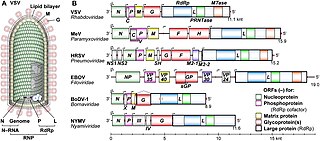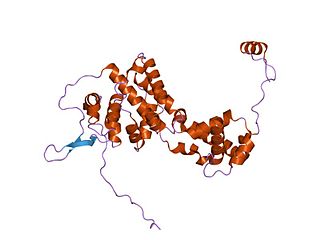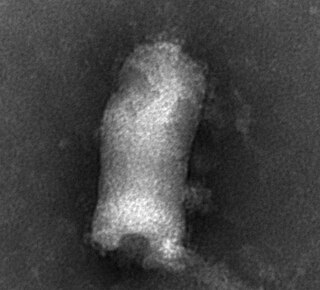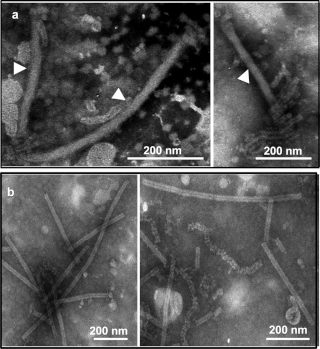Related Research Articles

Morbillivirus is a genus of viruses in the order Mononegavirales, in the family Paramyxoviridae. Humans, dogs, cats, cattle, seals, and cetaceans serve as natural hosts. This genus includes seven species. Diseases in humans associated with viruses classified in this genus include measles; in animals, they include acute febrile respiratory tract infection. In 2013, a wave of increased death among the Common bottlenose dolphin population was attributed to morbillivirus.

Mononegavirales is an order of negative-strand RNA viruses which have nonsegmented genomes. Some members that cause human disease in this order include Ebola virus, human respiratory syncytial virus, measles virus, mumps virus, Nipah virus, and rabies virus. Important pathogens of nonhuman animals and plants are also in the group. The order includes eleven virus families: Artoviridae, Bornaviridae, Filoviridae, Lispiviridae, Mymonaviridae, Nyamiviridae, Paramyxoviridae, Pneumoviridae, Rhabdoviridae, Sunviridae, and Xinmoviridae.

Bornaviridae is a family of negative-strand RNA viruses in the order Mononegavirales. Horses, sheep, cattle, rodents, birds, reptiles, and humans serve as natural hosts. Diseases associated with bornaviruses include Borna disease, a fatal neurologic disease of mammals restricted to central Europe; and proventricular dilatation disease (PDD) in birds. Bornaviruses may cause encephalitis in mammals like horses or sheep. The family includes 11 species assigned to three genera.
Betaarterivirus suid 1, commonly Porcine reproductive and respiratory syndrome virus (PRRSV), is a virus that causes a disease of pigs, called porcine reproductive and respiratory syndrome (PRRS), also known as blue-ear pig disease. This economically important, panzootic disease causes reproductive failure in breeding stock and respiratory tract illness in young pigs.

Vesiculovirus is a genus of negative-sense single-stranded RNA viruses in the family Rhabdoviridae, within the order Mononegavirales.

Novirhabdovirus is a genus of the family Rhabdoviridae containing viruses known to infect aquatic hosts. They can be transmitted from fish to fish or by waterborne virus, as well as through contaminated eggs. Replication and thermal inactivation temperatures are generally lower than for other rhabdoviruses, given the cold-blooded nature of their hosts. Hosts include a large and growing range of marine and freshwater fish.
The species Taï Forest ebolavirus is a virological taxon included in the genus Ebolavirus, family Filoviridae, order Mononegavirales. The species has a single virus member, Taï Forest virus (TAFV). The members of the species are called Taï Forest ebolaviruses.
The species Sudan ebolavirus is a virological taxon included in the genus Ebolavirus, family Filoviridae, order Mononegavirales. The species has a single virus member, Sudan virus (SUDV). The members of the species are called Sudan ebolaviruses. It was discovered in 1977 and causes Ebola clinically indistinguishable from the ebola Zaire strain, but is less transmissible than it. Unlike with ebola Zaire there is no vaccine available.

Spinareovirinae is a subfamily of double-stranded RNA viruses in the family Reoviridae. Viruses in this group are distinguished by the presence of a turreted protein on the inner capsid.

Nyamiviridae is a family of negative-strand RNA viruses in the order Mononegavirales. Ecdysozoa and birds serve as natural hosts. The name is a portmanteau of Nyamanini Pan and Midway Atoll and the suffix -viridae used to denote a virus family. There are seven genera in this family.
Ferlavirus, also referred to as Ophidian paramyxovirus, is a genus of viruses in the family Paramyxoviridae, order Mononegavirales. Reptiles serve as natural hosts. There is currently only one species in this genus to accommodate a single virus, Fer-de-Lance virus (FDLV).
Perhabdovirus is a genus of viruses in the family Rhabdoviridae, order Mononegavirales. Fish serve as natural hosts. Diseases associated with viruses of this genus include: breathing and swimming problems.
Sprivivirus is a genus of viruses in the family Rhabdoviridae, order Mononegavirales. Fish serve as natural hosts.

Mymonaviridae is a family of negative-strand RNA viruses in the order Mononegavirales, which infect fungi. Fungi serve as natural hosts. The name is a portmanteau of Ancient Greek myco, which means fungus, and mononegavirales. This family was established to accommodate Sclerotinia sclerotiorum negative-stranded RNA virus 1 (SsNSRV-1) a novel virus discovered in a hypovirulent strain of Sclerotinia sclerotiorum.

Pneumoviridae is a family of negative-strand RNA viruses in the order Mononegavirales. Humans, cattle, and rodents serve as natural hosts. Respiratory tract infections are associated with member viruses such as human respiratory syncytial virus. There are five species in the family which are divided between the genera Metapneumovirus and Orthopneumovirus. The family used to be considered as a sub-family of Paramyxoviridae, but has been reclassified as of 2016.
New Jersey polyomavirus is a virus of the polyomavirus family that infects human hosts. It was first identified in 2014 in a pancreatic transplant patient in New Jersey. It is the 13th and most recent human polyomavirus to be described.
Smacoviridae is a family of single-stranded DNA viruses. The genomes of this family are small. The name Smacoviridae stands for 'small circular genome virus'. The genomes are circular single-stranded DNA and encode rolling-circle replication initiation proteins (Rep) and unique capsid proteins. As of 2021, 12 genera and 84 species are recognized in this family. The viruses in this taxon were isolated from faecal samples from insects and vertebrates by metagenomic methods. Little is known about their biology.

Influenza A virus subtype H10N3 is a subtype of viruses that causes influenza (flu). It is mostly present in wild avian species. The first human case was reported in 2021.
Cruliviridae is a family of virus in the order of Bunyavirales. Unlike other families in the order, this family is unique in the sense that it is only used to contain crustacean-infecting bunyaviruses.
Brisavirus is a species of Redondoviridae in the genus Torbevirus. Brisa- is from the Spanish word for "Breeze", which refers to their isolation from the human respiratory tract. It was discovered in a throat swab in a male traveler who presented with fever, enlarged adenoids, flushed skin and myalgia after testing negative for other viruses. Brisavirus like other viruses in the Redondoviridae family, are present and putatively replicate in the oro-respiratory tract. They are associated in patients with critical illness and periodontitis.
References
- ↑ "Van Regenmortel, M. H. V." Library of Congress Name Authority File. Retrieved 11 January 2019.
- 1 2 Desselberger, Ulrich (1 August 2018). "Virus taxonomy—a taxing task". Archives of Virology . 163 (8): 2019–2020. doi:10.1007/s00705-018-3933-4. ISSN 1432-8798. PMID 30033496. S2CID 254047239.
- ↑ "Promises and Limits of Reductionism in the Biomedical Sciences". Wiley-Blackwell . Retrieved 11 January 2019.
- ↑ Skern, Tim (1 August 2018). "Editorial". Archives of Virology. 163 (8): 2017–2018. doi: 10.1007/s00705-018-3939-y . ISSN 1432-8798. PMID 30033494.
- ↑ "M.H.V. Van Regenmortel". Elsevier . Retrieved 11 January 2019.
- ↑ "Brief report from the Symposium to honour Marc van Regenmortel Vienna, 29th June, 2018". International Committee on Taxonomy of Viruses . 29 June 2018. Retrieved 11 January 2019.[ dead link ]